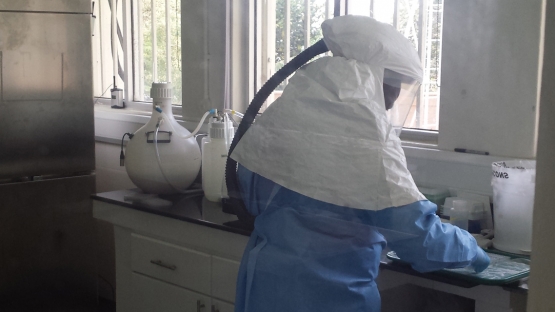Experts in Africa will be able to better track and detect animal diseases that could eventually be transmitted to humans as a result of a new € 2.7 million IAEA project. Over 20 experts from 13 countries met in Entebbe, Uganda, this week to firm up plans to improve regional capacity for the early detection of such zoonotic diseases, including the Ebola Virus Disease.
“One of the issues during the recent Ebola outbreak in West Africa was lack of preparedness,” said Michel Warnau, who oversees the project at the IAEA. “Through this project, we intend to reinforce existing capacities to diagnose zoonotic diseases early in order to better anticipate risks of outbreaks in human populations and implement appropriate preventive and control measures.”
The initiative supports the regional strategies of the World Health Organization (WHO) and the Food and Agriculture Organization of the United Nations (FAO) to strengthen the cooperation between human health and animal health experts and to increase preparedness. Experts from WHO and FAO also attended the Entebbe meeting.
The technical cooperation project will initially run for two years to train and equip diagnostic teams to better monitor wildlife and livestock for zoonotic diseases that could have major impact on humans. Priority will be given to viral haemorrhagic diseases such as Ebola, Marburg virus disease and Crimean-Congo haemorrhagic fever. The Joint FAO/IAEA Division of Nuclear Applications in Food and Agriculture will provide technical support to the project.
Recent Ebola outbreaks have had a major human, social and economic impact in West Africa. Since the WHO reported a major outbreak of Ebola in Guinea nearly one year ago, the disease has claimed the lives of nearly 10,000 victims across Liberia, Guinea, Sierra Leone, and elsewhere. In order to help limit the spread of diseases such as these, early detection in animals and wildlife is critical, Warnau said.
As human populations grow and spread into previously isolated environments, more and more people come into contact with formerly untouched wildlife and their maladies. Experts predict that in the future, outbreaks of current and new zoonotic diseases could be more diverse and even more severe than those the world has faced so far.
Nuclear-derived diagnostic techniques
The IAEA project makes use of nuclear-derived technologies to quickly diagnose the spread of viruses. Reverse Transcriptase Polymerase Chain Reaction (RT-PCR) and Enzyme-Linked ImmunoSorbent Assay (ELISA) are recognized as fast and efficient diagnostic techniques, and the IAEA has already supported the transfer and application of these technologies in several countries to help fight various diseases including rinderpest and H7N9 avian influenza.
The IAEA assistance also includes the reinforcement of national and regional networks to share epidemiological information faster and more efficiently, and to ensure national preparedness in the long run. “Right now international assistance is concentrated in the region so there is a lot of manpower, but the latter will not remain there,” Warnau said.
The project builds on previous support the IAEA provided to the region in the use of RT-PCR and other early-diagnostic tools under safe conditions. The Agency has also provided specialized diagnostic equipment to help Sierra Leone in its efforts to combat the ongoing Ebola outbreak. Next week the IAEA Board of Governors will review an additional project to ensure the sustainability of the early diagnosis effort and to enhance disease control in the region as a whole.
Funds for the current project have come from the United States, Japan and from the African Regional Cooperative Agreement for Research, Development and Training related to Nuclear Science and Technology (AFRA).


